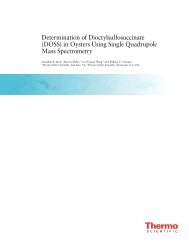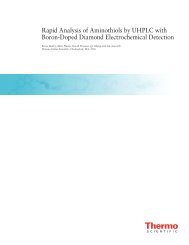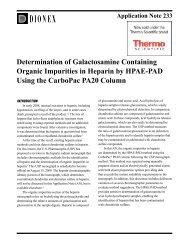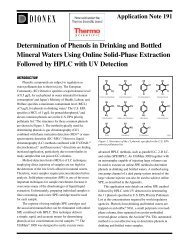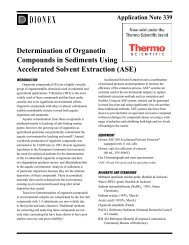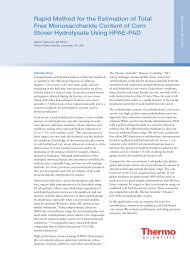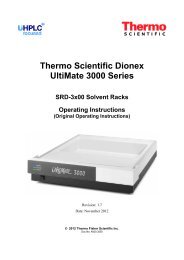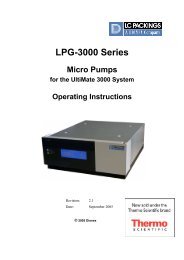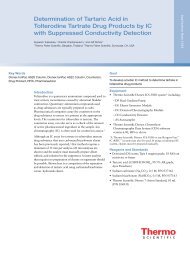Determination of Chlorite, Bromate, Bromide, and Chlorate ... - Dionex
Determination of Chlorite, Bromate, Bromide, and Chlorate ... - Dionex
Determination of Chlorite, Bromate, Bromide, and Chlorate ... - Dionex
Create successful ePaper yourself
Turn your PDF publications into a flip-book with our unique Google optimized e-Paper software.
4<br />
Eluent<br />
Autosampler<br />
Sample Loop<br />
DX-600 AG9-HC AS9-HC<br />
PC10 PCR<br />
Reservoir<br />
Figure 1. IC system configuration for EPA Method 326.0.<br />
AMMS III<br />
Suppressor<br />
Because the effluent from the conductivity detector cell<br />
will undergo a postcolumn reaction, install the <strong>Dionex</strong><br />
Anion Atlas Electrolytic Suppressor in the external water<br />
mode by following the Installation Instructions <strong>and</strong><br />
Troubleshooting Guide for the Anion Atlas Electrolytic<br />
Suppressor (Document No. 031770). Make sure that the<br />
pressure downstream from the Anion <strong>Dionex</strong> Atlas<br />
Electrolytic Suppressor does not exceed the recommended<br />
operating pressure <strong>of</strong> 20–100 psi. Use 0.02 in. i.d. PEEK<br />
tubing from the <strong>Dionex</strong> Anion Atlas Electrolytic Suppressor<br />
to the mixing tee, to the PCR coil, to the absorbance<br />
detector, <strong>and</strong> to waste, <strong>and</strong> keep it as short as is practical<br />
to minimize backpressure. Adjust the head pressure on<br />
the external water reservoir to deliver a flow rate <strong>of</strong><br />
5–10 mL/min (~10–15 psi). Use a current <strong>of</strong> 78 mA.<br />
Prepare the <strong>Dionex</strong> AMMS 300 suppressor (P/N 56750)<br />
for use by hydrating the eluent chamber. Use a disposable<br />
plastic syringe to slowly push approximately 3 mL <strong>of</strong><br />
0.2 N sulfuric acid through the Eluent Out port <strong>and</strong><br />
5 mL <strong>of</strong> 0.2 N sulfuric acid through the Regen In port.<br />
Allow the suppressor to sit for approximately 20 min to<br />
fully hydrate the suppressor screens <strong>and</strong> membranes.<br />
Install the <strong>Dionex</strong> AMMS 300 suppressor in the chemical<br />
regeneration mode by following the Installation Instructions<br />
<strong>and</strong> Troubleshooting Guide for the Anion<br />
Micromembrane Suppressor (Document No. 031727).<br />
Adjust the head pressure on the 0.3 N sulfuric acid<br />
reservoir to deliver a flow rate <strong>of</strong> 2–3 mL/min (~10–15 psi<br />
if a short piece <strong>of</strong> 0.01 in. i.d. PEEK tubing is connected<br />
to the <strong>Dionex</strong> AMMS 300 suppressor Regen Out port <strong>and</strong><br />
trimmed accordingly).<br />
Pump the eluent at 1.3 mL/min <strong>and</strong> set the PC10 pneumatic<br />
pressure to 70 psi. To measure the PCR flow rate,<br />
collect the effluent from the detector (that is, the total flow<br />
from the IC pump <strong>and</strong> PCR module) in a 10 mL graduated<br />
cylinder for 5 min. The PCR flow rate is the<br />
difference between the total flow rate <strong>and</strong> that <strong>of</strong> the IC<br />
pump. Adjust the air pressure <strong>of</strong> the PC10 postcolumn<br />
Mixing<br />
Tee<br />
UV Absorbance<br />
Detector<br />
Knitted RX Coil<br />
PCH-2 Heater at 80 C<br />
Atlas<br />
Suppressor<br />
Conductivity<br />
Detector<br />
Effluent to waste<br />
15691-01<br />
delivery module <strong>and</strong> remeasure the flow rate until the<br />
correct PCR flow rate <strong>of</strong> 0.4 mL/min is established.<br />
Variations in the PCR flow rate affect the postcolumn<br />
reaction time, pH, dilution, mixing rate, <strong>and</strong> ratio <strong>of</strong> the<br />
reactants. Stable day-to-day results depend on a well<br />
controlled PCR flow rate. Confirm this flow rate on a<br />
daily basis <strong>and</strong> whenever detector response for a calibration<br />
check st<strong>and</strong>ard deviates beyond quality control<br />
acceptance criteria.<br />
The storage solution 10 mM NaHCO 3 is shipped with the<br />
<strong>Dionex</strong> IonPac AS9-HC. After equilibrating the column<br />
with 9.0 mM carbonate eluent for 20 min, analyze a<br />
system blank <strong>of</strong> reagent water. An equilibrated system has<br />
a background conductance ~26 µs, with the peak-to-peak<br />
noise typically 1–2 nS per min. The background absorbance<br />
at 352 nm should be less than 200 mAU with peak<br />
to-peak noise <strong>of</strong> less than 50 µAU per min. There should<br />
be no peaks eluting within the retention time window <strong>of</strong><br />
the bromate anion. The column is equilibrated when two<br />
consecutive injections <strong>of</strong> a st<strong>and</strong>ard produce the same<br />
retention time for bromate.<br />
Results <strong>and</strong> Discussion<br />
Figure 2 shows the chromatograms <strong>of</strong> a mixed anion<br />
st<strong>and</strong>ard containing 5 µg/L each <strong>of</strong> chlorite, bromate,<br />
bromide, <strong>and</strong> chlorate. The top trace (A) was obtained<br />
with the conductivity detector <strong>and</strong> the bottom trace (B)<br />
was obtained with the UV/Vis absorbance detector after<br />
postcolumn reaction with acidified KI. The bromate peak<br />
is baseline resolved from chlorite on both detector<br />
channels. However, the response on the absorbance<br />
detector after PCR with acidified KI is significantly<br />
enhanced compared to the response obtained on the<br />
conductivity detector.<br />
Table 2 summarizes the calibration data <strong>and</strong> method<br />
detection limits (MDLs) obtained for the oxyhalide DBP<br />
anions <strong>and</strong> bromide using dual conductivity <strong>and</strong> UV<br />
detection. The MDL for each analyte was established by<br />
making eight replicate injections <strong>of</strong> a reagent water blank




